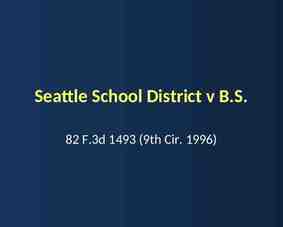Pacific Lutheran University Emergency Building Coordinator Training
53 Slides3.83 MB

Pacific Lutheran University Emergency Building Coordinator Training Program Session 1 of 4 The Basics

Training Series Content Basics EBC Roles & Responsibilities Emergency Procedures Documents/Forms Tools Emergency Response Incident Command PLU Emergency Plan PLU Guest Speakers Preparedness Prepare Mitigate Continuity of Operations Special Topics Make a Plan Care & Practice Critical Incident Stress Debriefing Tabletop Situational Exercises

What is an Emergency Incident? What is Emergency Management? An Emergency is any Emergency Management unplanned event that can cause deaths or significant injuries to employees, students, or the public; or that can shut down the university, disrupt operations, cause physical or environmental damage, or threaten it’s financial standing or public image. is the process of preparing for, mitigating, responding to and recovering from an emergency.

What is PLU Trying to Achieve During an Emergency or Crisis? Response Life – Safety Protection Incident Stabilization or Containment Property & Environmental Protection Recovery Get Back to Teaching/Business

Roll of an EBC Prepare Before an Incident Plan Inform / Train / During an Incident Manage Response for Building Collect & Communicate Educate Incident Maintain Resources Information Practice Build Redundancy!!!

Notification and Information PLU Alert! Website Voicemail Email Blue phone speakers Cable TV Alert System Fire Alarms Alarm Enunciators Incident / Weather Information Line 1.877.322.0872 http://flashalert.net Word-of-Mouth

Get Out - Evacuation Fire, Chemical, Earthquake, Bomb Building Evacuation Route Signs Disabled & Points of Refuge Emergency Assembly Areas Accountability Present / Absent Banner lists Building Status & Injury Report Form Business Hours vs. Non-business Hours

Stay In - Lock Down Atmospheric Threat – Lock Down & Move to Higher Ground Violent Incident – Lock Down and Stay Down (hide) Other Actions: Fight, Run or Crawl away, Play dead, Speak to captor Business Hours vs. Nonbusiness Hours

Emergency Procedures Resources In An Emergency guide Emergency Procedures Poster EBC procedures published by Emergency Programs Report Incidents 9-911 and CS @ x7911 Cell: 911 & 253-5357911 Media Civil Demonstrations Utility Failure

Tools Signs Radios Stay Use Instructions –in- Place Lock Relaydown Stations Emergency Assembly Point Megaphones Keys Caution Tape Vests

Summary EBCs/Res Hall Staff play a Critical Role Teams or Back-ups are Necessary Know Your Resources & How to Use Them Procedures Forms Communications Tools

Pacific Lutheran University Emergency Building Coordinator Training Program Session 2 of 4 Emergency Response

What Types of Emergencies Might Happen at PLU? Technological Earthquake Weather or Storm Incidents Flooding Utility Disruption Hazardous Materials Incidents Violent Incident Fire Atmospheric Contaminant Medical Social Unrest Structural Failures TerrorismCrash Airplane Financial Device Explosive

Real Incidents at PLU 3 Off-campus lock down incidents – 2011 & 2012 South Hall Pipe Breaks & Floods - Nov. 2010 Morken Fire – Nov 2010 South Hall / Ingram Pipe Breaks & Floods - Dec. 2009 Hot Weather and Power Outage - Aug. 2009 H1N1 Flu Pandemic - Spring – Fall 2009 Financial Crisis - Fall 2008 Harstad Sprinkler Break & Flood - Aug. 2007 Bomb Threat - May 2007 Wind Storm - Power Outage Dec. 2006 - Feb. 2007 Tetrahydrofuran Chemical Spill June 2006 Ingram Fish Tank Fire - July 2004 Natural Gas Line Vandalism & Release – Dec. 2005 Faculty Member Murdered on Campus - May 2001 Nisqually Earthquake - Feb 2001 Student Death in Off - Campus Deck Collapse – May 2001

The National Incident Management System (NIMS), Incident Command System (ICS) & PLU Emergency Management Plan for All Hazards

National Incident Management System or NIMS A system that provides for a consistent nationwide approach for governments and private sector entities to work effectively and efficiently together to prepare for, respond to, and recover from incidents, regardless of size, cause, or complexity Includes a core set of principles, concepts and terminology, including ICS; multiagency coordination systems; training; identification and management of resources; qualification and certification; and collection, tracking, and reporting of incident information and incident resources. PLU formally adopted this system in 2008 with a presidential resolution.

Incident Command System (ICS) A standardized on-scene emergency management construct It is a combination of facilities, equipment, personnel, procedures, and communications that operate within a common integrated organizational structure to aid in managing resources. Used in small to complex incidents

ICS Features Common terminology Modular/scalable organization Management by objectives Reliance on an incident action plan (IAP) Chain of command and unity of command (report to one and only one person) Unified (shared) command Span of control Pre-designated incident locations and facilities Resource management Information and intelligence management Integrated communications Transfer of command Accountability Mobilization

ICS Philosophy Manage Objectives Priorities Life Safety Incident Stabilization Property & Environmental Preservation Recovery - Getting Back to Business/Teaching

PLU All Hazards Emergency Management Plan Personal Responsibility Departmental Responsibility EBC & Resident Hall Staff Role Accountability Communication Knowledge and Leadership

PLU All Hazards Emergency Management Plan 4 Phases Mutual Aid Agreements Authority & Procedures for Activating the Plan Emergency Activation Levels Incident Command Emergency Coordination Team (ECT) ICS / ECT Interface Organization Accountability Operation Task Lists

PLU Incident Response Organization Emergency Coordination Team Policy Group Emergency Coordinator Operations Group Resources Group Coordination Group Incident Commander and Command Staff Includes Safety Officer, Public Information Officer, and Liaison Officer Operations Section Planning Section Logistics Section Incident Command Finance Section

PLU Incident Response Organization Policy Group Incident Commander and Command Staff Public Information Officer, Safety Officer, Liaison Officer Operations Section Campus Safety (security / traffic man.) Planning Section Logistics Section Finance Section Chief Situation Unit Responder Service Branch (Communications, Medical, Food) Insurance/ FEMA/Risk Management Unit Facilities Management (utility, grounds, structures, clean-up) Resources (people) Unit Residential Life (shelter - students) Documentation Unit Health Center (physical and mental) Demobilization Unit Campus Ministry Technical Specialists Dining (food & water) Information & Technology Services Auxiliaries (space, access, guests) Student Involvement & Leadership (students) Academics Accountability (EBC / RA Liaison) Search & Rescue Support Branch (Supplies, Incident Facilities, Transportation) Procurement Unit Time (Payroll) Unit Cost Unit

PLU Speakers Public Information Officer – Donna Gibbs Accountability & Human Resources – Teri Phillips Residential Life / Shelter Operation – Tom Huelsbeck Facilities Operation – Tom Huelsbeck Campus Safety Operation – Greg Premo

How to Handle the Public? Give event organizers the PLU emergency procedures before coming to campus. Treat the public as you would students and faculty. An “outsider” may also be a resource.

In Summary PLU uses a national standard of emergency response The national standard and PLU plan can be applied to all incident types and scales All personnel have responsibility to prepare for emergencies EBCs & resident hall staff play a critical role

Pacific Lutheran University Emergency Building Coordinator Training Program Session 3 of 4 Preparation & Special Topics

Prepare “Planning ahead for emergencies is part of normal business planning and campus life, and all members of the campus community share a responsibility for preparedness”

EBC/Employee Priorities Me My Family Others (PLU)

Supplies and Equipment Home Family Office / EBC PLU Emergency Response First Aid / AEDs

Preparedness PLU weather closure policy always encourages self-determination. Have personal emergency supplies. Create a security threat “password”. Learn how to use a fire extinguisher. Learn how to apply 1st aid or use an AED. Know what to expect or how to respond during an incident.

Mitigation Hazard mitigation means taking action to reduce or prevent future damage or reduce the scale of damage, preferably before a disaster strikes.

PLU Mitigation Plan Components Building Seismic Upgrades Card Access Security System Fire Alarms and Voice Enunciators Fresh Air Intake Shut-offs Non-structural Earthquake Devices Generators

What Can You Do? Install earthquake fasteners on critical equipment. Duplicate and store research data, samples, manuscripts off site. Store critical materials/equipment above ground away from flood damage. Keep hallways and emergency exits clear Strap or move file cabinets and bookshelves away from doors

Continuity of Operations Plan (COOP): Definition & Scope COOP includes. . . The activities of individual departments and offices to ensure that their essential functions are performed Plans and procedures to ensure that essential functions are performed. Tests, training, and exercises to ensure a viable COOP capability

COOP Overview: Planning Objectives Ensure continued performance of essential functions Reduce loss of life/minimize damage Ensure succession to office of key leadership Reduce/mitigate disruptions to operations Protect essential assets Achieve timely recovery/reconstitution Maintain tests, training & exercise program for validation

COOP: Get Ready PLU is currently working on an Essential Personnel Plan Identify essential functions in your office. Identify essential personnel to carry out those functions. Identify resource needs and dependencies. What facilities are available to carry out the work? What communications are available? Remember personal and family emergency preparedness as it relates to the personnel who are available during an emergency to carry out the essential functions. Maintain the plan.

Vulnerable Populations Preparing With and Assisting Disabled

Public & Assertiveness Guests, Faculty, Staff, Students, Media They Want: Be Safe Know What To Do Information Tell Them Be Direct Simple Instructions Send Media to UComm PRACTICE!

Make/Update a Plan Three Types of Plan Response Plan – What you do to protect LIP Stay –In-Place and Lock Down – A type of response plan Continuity – What you do to enable continuation of essential services/functions

Pacific Lutheran University Emergency Building Coordinator Training Program Session 4 of 4 Care and Practice

Drill or Exercise An Exercise is a focused practice activity that places the participants in a simulated situation requiring them to function in the capacity that would be expected of them in a real event. Its purpose is to promote preparedness by testing policies and plans and training personnel. PLU conducts exercises every year: Evacuation, Earthquake, Officer and Administrator Tabletops FEMA Emergency Management Institute Exercise Design Independent Study, March 2003

Tabletop Exercise A tabletop exercise simulates an emergency situation in an informal, stress-free environment. People gather around a table to discuss general problems and procedures in the context of an emergency scenario. Focus is on training and familiarization with roles, procedures, or responsibilities.

Fire You notice smoke coming from behind your desk on the first floor, which quickly turns to flames. There is a wheelchair bound co-worker on the second floor. After evacuating, What actions do you take? What do you expect others to do?

Earthquake There is a 6.2 earthquake at 10:00 a.m. You notice a student who was hit in the head with a brick from the building as he ran outside during the earthquake. Several people are overwhelmed with What action do you take? What do you expect others to do?

Civil Disturbance There is a civil What actions do demonstration on you take? campus sponsored and What do you expect supported by PLU others to do? students. The media is here to cover the story and they are asking you and others questions. The crowd storms your

Threat of Violence There is a loud, angry conversation What actioncoming do you from the closed office oftake? a faculty member in your building. What do you expect You hear “I’m going to get others you!” to do?

Threat of Violence Continued Student involved in that discussion is escorted off campus and listed as restricted from campus on the Campus Safety website. She returns to your building the next day and says she What action do you take? What do you expect others to do?

Weather Closure A big snow and ice storm has triggered the cancellation of classes. There is a power outage affecting all of campus. It has been almost 5 hours since it started and it is unknown when the power will come back on. What services in your office or around campus must continue to be offered? Who and how will the services be carried out?

Call to Action Make a Family Emergency Plan Prepare PLU Roll Call Sheets Know PLU Procedures Communicate with Colleagues Help Your Building/Office Prepare & Plan Practice PLU Procedures Practice Self-Care

Continuity What The campus essential hasservices been does your department provide to support–teaching closed students and and sheltering? employees sentdept home How will your continue to provide those services in a due to local cases of avian campus closure environment? flu. Do you have contact lists for everyone in your dept? The Provost says the university will continue to teach enrolled students. About 200 students cannot be sent home and are living on campus.

Session 4 Complete!







